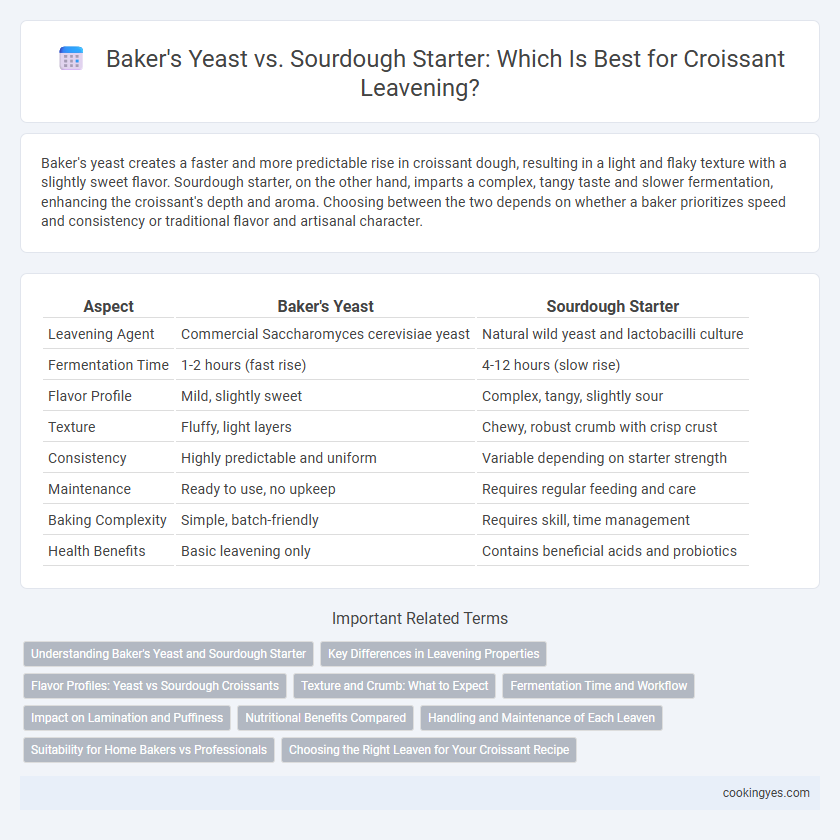Baker's yeast creates a faster and more predictable rise in croissant dough, resulting in a light and flaky texture with a slightly sweet flavor. Sourdough starter, on the other hand, imparts a complex, tangy taste and slower fermentation, enhancing the croissant's depth and aroma. Choosing between the two depends on whether a baker prioritizes speed and consistency or traditional flavor and artisanal character.
Table of Comparison
| Aspect | Baker's Yeast | Sourdough Starter |
|---|---|---|
| Leavening Agent | Commercial Saccharomyces cerevisiae yeast | Natural wild yeast and lactobacilli culture |
| Fermentation Time | 1-2 hours (fast rise) | 4-12 hours (slow rise) |
| Flavor Profile | Mild, slightly sweet | Complex, tangy, slightly sour |
| Texture | Fluffy, light layers | Chewy, robust crumb with crisp crust |
| Consistency | Highly predictable and uniform | Variable depending on starter strength |
| Maintenance | Ready to use, no upkeep | Requires regular feeding and care |
| Baking Complexity | Simple, batch-friendly | Requires skill, time management |
| Health Benefits | Basic leavening only | Contains beneficial acids and probiotics |
Understanding Baker's Yeast and Sourdough Starter
Baker's yeast, a commercially cultivated strain of Saccharomyces cerevisiae, provides rapid and predictable fermentation, ensuring consistent croissant dough rise and a light, airy texture. Sourdough starter contains wild yeasts and lactic acid bacteria, producing slower fermentation and a complex flavor profile with subtle tanginess and deeper crust development. Understanding the biochemical differences between baker's yeast and sourdough starter helps bakers choose between quick leavening and enhanced flavor complexity in croissant production.
Key Differences in Leavening Properties
Baker's yeast delivers rapid fermentation and consistent carbon dioxide production, resulting in a light, flaky croissant texture. Sourdough starter offers a slower, natural leavening process with complex flavors due to wild yeast and lactic acid bacteria activity. The acidification from sourdough contributes to a stronger gluten network, enhancing dough elasticity and shelf life compared to baker's yeast.
Flavor Profiles: Yeast vs Sourdough Croissants
Baker's yeast croissants offer a clean, slightly sweet flavor with a tender, airy crumb, while sourdough starter croissants present a complex, tangy taste due to natural fermentation and lactic acid bacteria. The sourdough process enhances depth and richness in flavor, producing subtle acidity and a chewier texture compared to the more neutral profile of yeast-leavened croissants. Both methods impact aroma and mouthfeel, with sourdough croissants often prized for their artisanal character and extended shelf life.
Texture and Crumb: What to Expect
Baker's yeast produces a lighter, more consistent crumb with a fluffy texture ideal for traditional croissants, offering rapid fermentation that enhances dough elasticity and rise. Sourdough starter fermentation yields a denser, chewier crumb with complex flavor notes and a slightly irregular, open texture due to slower fermentation and natural acids. Croissants made with sourdough often exhibit a richer aroma and a more artisanal, rustic texture, while baker's yeast excels in producing the classic flaky layers.
Fermentation Time and Workflow
Baker's yeast accelerates fermentation in croissant dough, typically requiring 1 to 2 hours of proofing, which streamlines the workflow for commercial bakeries aiming for faster production. Sourdough starter extends fermentation time to 8 to 24 hours, enhancing flavor complexity through natural lactobacilli activity but demands meticulous planning and temperature control. Selecting between baker's yeast and sourdough starter influences the croissant's texture and tang, balancing efficiency and artisanal quality in the baking process.
Impact on Lamination and Puffiness
Baker's yeast produces a faster, more consistent rise that enhances lamination by creating uniform gas bubbles, resulting in well-defined, flaky layers and pronounced puffiness in croissants. Sourdough starter, with its slower fermentation, develops complex flavors but can produce irregular gas bubbles that may weaken lamination, leading to a less uniform crumb structure and reduced lift. Optimal puffiness in croissants relies on the precise balance of gas production and dough elasticity, where baker's yeast generally provides superior control over lamination quality.
Nutritional Benefits Compared
Baker's yeast croissants typically contain fewer probiotics and lower nutritional complexity compared to sourdough starter croissants, which benefit from natural fermentation producing vitamins and minerals like B vitamins and folate. Sourdough fermentation enhances digestibility and may reduce gluten content by breaking down complex carbohydrates and proteins. Nutritional advantages of sourdough croissants include increased bioavailability of nutrients and potential positive effects on gut health.
Handling and Maintenance of Each Leaven
Baker's yeast requires minimal handling and is easy to maintain, needing only refrigeration and infrequent feeding, which suits consistent, quick croissant production. Sourdough starter demands regular feedings and careful temperature control to maintain its microbial balance, resulting in more complex flavors but increased maintenance effort. Proper care of each leaven affects fermentation time, dough elasticity, and ultimately, the croissant's texture and taste.
Suitability for Home Bakers vs Professionals
Baker's yeast offers consistent rise and faster fermentation, making it ideal for home bakers seeking reliable, convenient croissant baking without lengthy preparation times. Sourdough starter provides complex flavor development and unique texture preferred by professionals who value artisanal quality and longer proofing processes. Home bakers benefit from the predictability of baker's yeast, while professional bakers leverage sourdough starter's depth and fermentation control for premium croissant craftsmanship.
Choosing the Right Leaven for Your Croissant Recipe
Choosing the right leaven for your croissant recipe significantly impacts texture and flavor development. Baker's yeast provides faster fermentation, resulting in a lighter, airier crumb, while sourdough starter offers complex tangy notes and a chewier texture due to natural wild yeast and lactic acid bacteria. Balancing fermentation time with desired taste profile helps achieve authentic, flaky layers characteristic of traditional croissants.
Baker's yeast vs sourdough starter for croissant leavening Infographic

 cookingyes.com
cookingyes.com